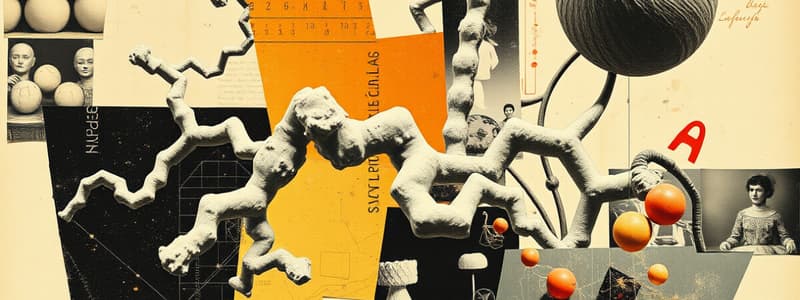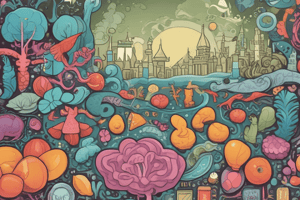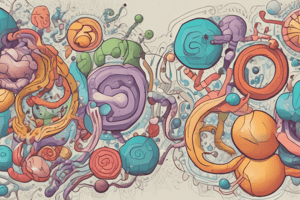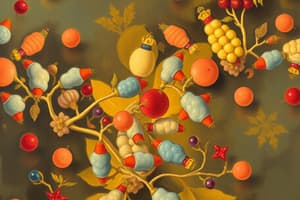Podcast
Questions and Answers
What are proteins made up of?
What are proteins made up of?
Nitrogen, oxygen, hydrogen, and carbon.
How many proteins make up the body?
How many proteins make up the body?
Thousands.
What are the basic functions of proteins?
What are the basic functions of proteins?
Regulates and maintains body functions; provides essential form of nitrogen (in the form of amino acids).
In the developed world, the diet is typically low in protein.
In the developed world, the diet is typically low in protein.
People in the developing world often experience protein deficiency.
People in the developing world often experience protein deficiency.
Aside from water, protein makes up the major part of the?
Aside from water, protein makes up the major part of the?
Proteins account for what percent of total body weight?
Proteins account for what percent of total body weight?
What are the building blocks of proteins?
What are the building blocks of proteins?
What do amino acids contain that makes them unique from carbohydrates and fats?
What do amino acids contain that makes them unique from carbohydrates and fats?
What is the amino acid structure?
What is the amino acid structure?
The side group for each amino acid is?
The side group for each amino acid is?
The proteins in our bodies are made up of how many different types of amino acids?
The proteins in our bodies are made up of how many different types of amino acids?
How many essential amino acids are there?
How many essential amino acids are there?
How many non-essential amino acids are there?
How many non-essential amino acids are there?
What connects amino acids together?
What connects amino acids together?
What is a dipeptide?
What is a dipeptide?
What is a tripeptide?
What is a tripeptide?
Many amino acids form a?
Many amino acids form a?
Protein primary structure is determined by?
Protein primary structure is determined by?
Higher order protein structure causes the protein to?
Higher order protein structure causes the protein to?
What is native conformation?
What is native conformation?
What is denaturation?
What is denaturation?
Where is DNA found and what does it determine?
Where is DNA found and what does it determine?
What is mRNA?
What is mRNA?
What kinds of jobs do proteins do?
What kinds of jobs do proteins do?
What is the first process in sickle cell anemia?
What is the first process in sickle cell anemia?
What changes in the second process of sickle cell anemia?
What changes in the second process of sickle cell anemia?
What happens in the third process of sickle cell anemia?
What happens in the third process of sickle cell anemia?
What happens in the fourth process of sickle cell anemia?
What happens in the fourth process of sickle cell anemia?
What occurs in the fifth process of sickle cell anemia?
What occurs in the fifth process of sickle cell anemia?
Where does digestion begin for proteins?
Where does digestion begin for proteins?
Where does pre-digestion begin for proteins?
Where does pre-digestion begin for proteins?
What is gastrin?
What is gastrin?
What is chyme?
What is chyme?
What does pepsin do?
What does pepsin do?
What does CCK do?
What does CCK do?
When is pepsin inactivated?
When is pepsin inactivated?
What are some functions of proteins in the body?
What are some functions of proteins in the body?
What happens with protein inadequacy in the body?
What happens with protein inadequacy in the body?
What occurs with fluid balance in relation to proteins?
What occurs with fluid balance in relation to proteins?
What are some issues with high protein diets?
What are some issues with high protein diets?
What cancer is high protein diets linked with?
What cancer is high protein diets linked with?
What is a vegetarian?
What is a vegetarian?
What is a vegan?
What is a vegan?
What is a semi-vegetarian?
What is a semi-vegetarian?
What are complete proteins?
What are complete proteins?
What are plant proteins?
What are plant proteins?
What foods are low in the amino acid lysine?
What foods are low in the amino acid lysine?
What foods are low in amino acids and methionine?
What foods are low in amino acids and methionine?
What are complementary proteins?
What are complementary proteins?
What do protein needs depend on?
What do protein needs depend on?
What is the normal protein breakdown?
What is the normal protein breakdown?
What contributes to satiety?
What contributes to satiety?
How many grams of protein do men typically take in?
How many grams of protein do men typically take in?
How many grams of protein do women typically take in?
How many grams of protein do women typically take in?
What is the food and nutrition board set amount of protein intake?
What is the food and nutrition board set amount of protein intake?
When is protein needed for energy?
When is protein needed for energy?
What is the main source of energy for the body?
What is the main source of energy for the body?
What happens to amino acids when glucose is low?
What happens to amino acids when glucose is low?
What happens with starvation?
What happens with starvation?
What is one function of proteins in hormones?
What is one function of proteins in hormones?
What is the function of proteins as enzymes?
What is the function of proteins as enzymes?
How do proteins help in maintaining acid-base balance?
How do proteins help in maintaining acid-base balance?
What happens with protein inadequacy relating to fluid balance?
What happens with protein inadequacy relating to fluid balance?
How are amino acids absorbed?
How are amino acids absorbed?
Flashcards are hidden until you start studying
Study Notes
Proteins Overview
- Composed of nitrogen, oxygen, hydrogen, and carbon.
- Essential for body functions and the body's major component after water.
Protein Functions
- Regulate and maintain biological processes.
- Provide nitrogen through amino acids.
- Essential roles include structural support, enzyme activity, hormone production, immune response, transport, and receptor functions.
Protein Consumption Patterns
- Developed nations typically have a protein-rich diet.
- Developing nations often suffer from protein deficiencies.
Protein Composition
- Proteins account for roughly 17% of total body weight.
- Made from 20 different amino acids, which include 9 essential and 11 non-essential amino acids.
- Amino acids are unique due to their side groups.
Protein Structure
- Primary structure defined by the sequence of amino acids.
- Higher-order structure determines protein shape, crucial for function.
- Denaturation disrupts protein structure; causes include heat and pH changes.
Protein Synthesis
- DNA in the cell nucleus dictates primary protein structure.
- mRNA transcription from DNA occurs, leading to protein translation in the rough endoplasmic reticulum.
Digestion and Absorption
- Protein digestion begins in the stomach due to cooking (denaturation).
- Gastrin hormone initiates pepsin secretion for protein breakdown.
- CCK hormone triggers release of proteolytic enzymes in the small intestine.
Sickle Cell Anemia
- Results from a change in the amino acid sequence in hemoglobin, leading to altered structure and reduced function.
Consequences of Protein Deficiency
- Can lead to muscle wasting, organ shrinkage, and impaired immune function.
- Essential for maintaining fluid balance; deficiency can cause edema.
Protein Sources
- Complete proteins (animal sources) contain all essential amino acids.
- Plant proteins are often incomplete and may lack specific amino acids.
- Combining different plant proteins can ensure a complete amino acid profile.
Protein Requirements
- Daily intake varies by gender; men typically require around 100 grams while women need about 65 grams.
- Recommended protein intake is 10-35% of total calories.
Special Functions of Protein
- Can provide energy when carbohydrate intake is low.
- Amino acids serve as precursors for glucose synthesis during starvation.
- Critical for maintaining acid-base balance in physiological processes.
Health Considerations
- High-protein diets can lead to kidney stress and increased calcium loss.
- Linked to higher colon cancer risk, particularly from processed meats.
Amino Acid Absorption
- Absorbed by capillaries, transported to the liver.
- Utilized for protein synthesis, energy, or converted into fat and glucose.
Studying That Suits You
Use AI to generate personalized quizzes and flashcards to suit your learning preferences.




